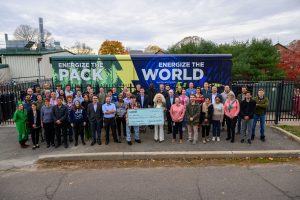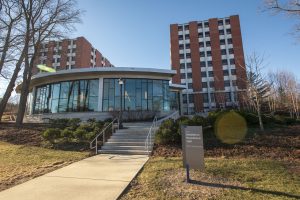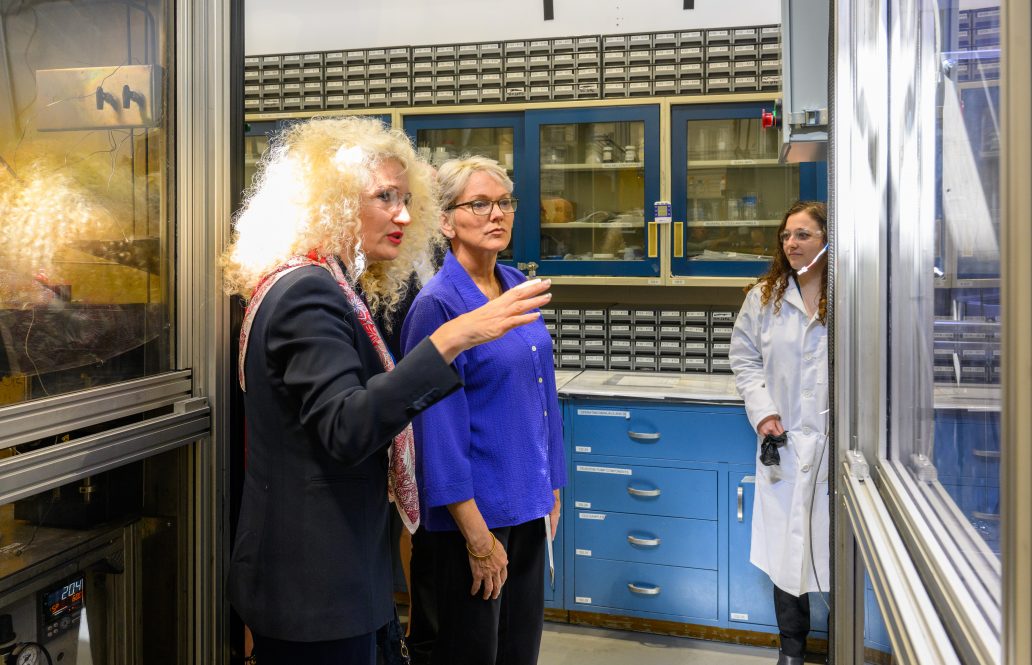UConn will build on its culture of environmental sustainability with aspirations to achieve carbon neutrality on campus by 2030, making it a living laboratory to develop and demonstrate new approaches to mitigating climate change’s harmful effects.
President Radenka Maric, an internationally known expert in clean energy research, announced the carbon-neutral plan recently in a letter to the UConn community. Specifics on the vision, goals, and targets for various initiatives will be outlined in a comprehensive Sustainability Action Plan to be released in the spring.
UConn has the institutional commitment, student support, research expertise, academic strength, and industry partnerships to achieve the goal, and to compete for state and federal funding to develop and demonstrate the technologies, Maric says.
Those technologies include science-based solutions for managing the risks of climate change, community-level communication, and developing engagement strategies to ensure long-term sustainability and equity in clean energy transition.
“Our vision is for UConn to be a global leader in the international campaign to address the existing threat posed by climate change. We are committed to advancing sustainability in all we do,” Maric said recently, when delving more deeply into the specifics with a presentation at a recent Board of Trustees meeting.
“Our strategy is to address the existential threat posed by climate change through a comprehensive and holistic approach, through educating our students, through community engagement, and through research and working with our partners in industry, the federal government and state,” she said.
The sustainability initiatives will cross many areas of the University, including revamping how it provides clean energy to operate its buildings and vehicles, and expanding opportunities for students to participate in research through experiential learning opportunities.
In fact, UConn already has laid a strong foundation on which to continue reducing its carbon footprint by employing green technology such as the Depot Campus fuel cell, powering buildings and providing heat more efficiently than the grid; and expanding its academic programs in sustainability topics.

UConn’s efforts have also been noticed at the national level, including during a visit last spring by U.S. Secretary of Energy Jennifer Granholm, who noted UConn’s major contributions to the field.
In addition to drawing from faculty and student expertise within the University, UConn’s pursuit of carbon neutrality will include partnering with state and federal agencies along with industry and other groups to receive funding and develop new technologies together.
Maric noted that the federal government has developed several incentive programs to support hydrogen energy and power grid resilience research. In fact, UConn is partnering with several other East Coast institutions in seeking to host a regional Northeast Hydrogen Hub, as envisioned in the 2021 federal Infrastructure Investment and Jobs Act.
“I always think we can push ourselves the extra mile, but every extra mile requires extra dollars, and this is where I’m going to push. There are unprecedented opportunities when it comes to federal government initiatives,” she said.
“There are unique things that we can do at this campus that no other campus is doing. We have the vision, interdisciplinary science, and technologies ready and have to start implementation. Through those many bills, there are going to be financial incentives and opportunities for us to implement these plans,” she added.
UConn’s Sustainability Action Plan, which will be posted on the President’s website in the spring, will outline specifics of the vision, goals, and targets for sustainability initiatives on UConn’s campuses. New initiatives are expected to be posted monthly, and the University will review the goals and progress annually, Maric said.
She noted that environmental justice is a critical component of UConn’s efforts, and that achieving equitable sustainability will require recognizing and including people and groups who historically have been underrepresented and exploited worldwide.
Energy justice will require technological solutions that respond to diverse societal interests, social norms, consumer behavior patterns, and power dynamics. It also will include preemptively seeking solutions to problems plaguing the conventional energy sector and climate adaptation efforts, including equity, safety, and accessibility across diverse communities and demographics.
Several UConn students who have been actively advocating for climate action on its campuses met earlier this fall with Maric and shared positive feedback with trustees about UConn’s sustainability aspirations. They also emphasized the need to keep students informed and deeply involved at all steps of the process.
“The recent announcement to pursue carbon neutrality by 2030 has made me so proud to be a UConn student, and I hope that with the support of an impassioned and educated student body, we can make those dreams a reality and even go beyond,” environmental studies major Holly Garfield ’24 (CLAS) told trustees at a recent meeting.
Where We Are: Facilities Operations, Academics, and Other Initiatives
A major part of the carbon-neutrality movement will include changes envisioned in how UConn provides energy to its on-campus facilities at Storrs.
The majority of its energy is generated by the natural gas-powered Cogeneration Plant, which went online in 2006 to replace older, carbon-intensive oil-fired burners.
Through cogeneration, more than 80% of the fuel energy can be harnessed, versus 33% from a conventional electric power plant – all of which has made it a more efficient, green-friendly approach to providing the energy that powers UConn Storrs.
UConn Facilities Operations has been incorporating sustainability and conservation measures into its projects for several years, and its leaders are working with Maric and others in the University on ideas to continue that progress with new and emerging technologies.

Progress is already being made: Despite a 44% increase in on-campus square footage since 2000 due to new and expanded buildings, UConn Storrs has reduced its greenhouse gas emissions by 25% from the baseline amounts 20-plus years ago.
The Depot Campus is also powered by a HyAxiom fuel cell that provides 100% of the power required for the campus, plus heating for the Center for Clean Energy Engineering (C2E2) research laboratories.
UConn also has received LEED Gold status from the U.S. Green Building Council on five construction projects, plus several others with silver certifications, since adopting a policy in 2007 for sustainable methods in all major projects.
LEED-certified buildings are designed with methods to conserve energy and water, cut down on waste sent to landfills, reduce harmful greenhouse gas emissions, reduce operating costs, and ensure a healthy environment for occupants.
Michael Jednak, UConn’s associate vice president for facilities operations, told trustees at their recent presentation that the University is also reinvesting renewable energy credit payments back into sustainability measures on campus.
UConn receives about $2.5 million in those payments annually and, because it invests that money back into green efforts, it also gets an enhanced Eversource Energy conservation rebate of about $2.5 million annually.
The combined $5 million goes back into conservation, such as the recent work to transition more than 75%, so far, of the on-campus lighting at Storrs from traditional bulbs to LED (light-emitting diodes). They use up to 90% less energy and last up to 25% longer than incandescent bulbs.
Sustainability efforts also are in place throughout many parts of campus, covering a wide range of operations and facilities from water reclamation to locally sourcing much of the food served in dining halls and other establishments.
For instance, UConn Dining Services diverts most of its food waste for renewable biofuel energy and compost. UConn also installs sustainable building features wherever possible, such as the “green” plant-covered roofs on several buildings and the solar energy array at the Peter J. Werth Residence Tower — which has avoided more than 241,000 pounds of CO2 since 2017.
UConn also has built a strong academic foundation on which to expand, with a wide range of majors directly or partially related to sustainability and the environment along with two dozen graduate and post-graduate programs.
UConn launched an environmental literacy general educational requirement in 2019 that ensures students graduate having taken at least one three-credit course anchored to environmental topics. It’s not limited to science; the requirement encourages students to look at environmental issues in a broad view, encompassing everything from political science to the arts.
“We have a wide number of educational resources in terms of training our students to be the next generation of leaders around the environment and sustainability,” said UConn Provost Anne D’Alleva, adding that she has talked with students about their ideas on widening the environmental literacy requirement to include more courses and disciplines so it can grow and evolve.
Multiple undergraduate majors and minors are focused on environmental issues, including the programs in environmental studies, environmental sciences, geography, natural resources and the environment, ecology and evolutionary biology, marine sciences, Earth sciences, energy and environmental law, and environmental engineering.
Because climate change is rooted in human behavior, UConn’s programs in anthropology, political science, sociology, law, history, psychological sciences, and human rights are also crucial for sustainability in practice.
Experiential learning through internships, research, and other activities has also been a strong element of UConn’s commitment to sustainability. For example, UConn students annually attend the United Nations Conference of the Parties (COP) climate summit, where the University’s official observer status provides the students with unrestricted access to world leaders, scientists, and negotiators.
“We have many ways in which our students are directly engaged in research through their learning,” D’Alleva said.
Where We’re Going: Research, Academics, Clean Energy for Facilities
Moving forward, Maric and other UConn leaders say the University should expand areas in which it’s achieving sustainability success, while also exploring new technologies that could help not only the campus, but the broader state and society as a whole.
UConn’s Facilities Operations and the Planning, Design, and Construction departments have embedded many environmental principles in their work and have more ahead in coming years, such as designing the new Science 1 Research Building to have a 500 kW rooftop photovoltaic solar array and vegetated bioswale that will capture and filter stormwater flow.
The building also has many other features that reduce energy usage. For example, it has triple-pane glazing that acts as an insulator, greatly cutting heat or cooling losses. The laboratory fume hoods are high-efficiency with minimal energy use and are equipped with automatic sash closers, allowing heat from the lab exhaust systems to be recaptured and used in the lab supply air systems.
All of the lighting provided in the building comes from high-efficiency LED fixtures. In addition, all of the spaces are equipped with occupancy/vacancy motion sensors, ensuring the lights turn off automatically if the space is unoccupied. Science 1 has also been built with locally sourced gravel, recycled steel, and wood that has been certified as sustainable by the Forest Stewardship Council.
Many students will also be living right in the midst of UConn’s newest sustainable residential buildings: the apartments slated to replace Mansfield Apartments, and the new residence hall planned for construction on South Campus.
With fuel cells generating most of its electricity and geothermal heat pumps used for the majority of its heating and cooling, the new complex on the Mansfield Apartments site will be among the most environmentally self-sustaining facilities on campus when it opens in fall 2025.
The potential for geothermal heat pumps is also being reviewed for the new South Campus residence hall and dining facility, where sustainability efforts inside and outside of the complex will address a range of priorities such as energy conservation, stormwater management, and a solar array on the dining hall roof.
Jednak says the Facilities Operations department also is reviewing ways to potentially add a solar array on the roof of the Cogen Plant and explore other technologies to increase carbon capture there. He said they also will watch for opportunities to make other sustainability upgrades when addressing energy issues elsewhere on campus, sometimes using other universities’ successes as blueprints.
“One of the really neat things in higher education is that we share our information. There’s nothing private about it; there’s no competition other than, ‘Let’s share our information and see if we can make everything better’,” Jednak said at the recent trustees meeting.
In fact, UConn’s partnerships span oceans: UConn and the Technion-Israel Institute of Technology have a highly collaborative Clean Energy Initiative in which faculty and students from both institutions work together on energy engineering and education projects, including ways to commercialize fuel cells for widespread public use.

And while UConn is thinking globally, it also is acting locally, Maric says, such as examining the feasibility of replacing University fleet vehicles that use fossil fuels with others that run on clean energy sources such as hydrogen.
UConn’s clean-energy and sustainability research will also continue to grow in coming years, Maric said, noting that hundreds of faculty members across multiple disciplines are directly involved in research aligning with climate change mitigation, clean energy research, and sustainability. They hold more than 600 research grants already, with the potential for many more to come.
Their work crosses multiple schools and colleges, and includes many centers and laboratories such as the Connecticut Center for Clean Energy Engineering, Institute of the Environment, Connecticut Institute for Resilience and Climate Adaptation, Climate Resource Exchange, and Eversource Energy Center.
New initiatives are also underway, such as the newly launched Future Climate Venture Studio to incubate new start-up companies at UConn and in Connecticut; the recent institutional partnership with the U.S. Department of Energy’s (DOE) National Renewable Energy Lab (NREL) on clean energy and grid resilience; and the recently established Connecticut National Estuarine Research Reserve (NERR) that encompasses the Avery Point campus, and provides a wealth of opportunities along the shoreline for student and faculty research.
Several potential ideas for reducing UConn’s carbon footprint were included in a 2021 report of the President’s Working Group on Sustainability and the Environment, which originally envisioned carbon neutrality on campus by 2040, a goal that Maric has accelerated by 10 years to 2030.
The 2021 report included envisioning a microgrid based at Depot Campus that uses solar and fuel cell energy to create and supply on-campus clean energy, solar arrays on canopies over campus parking lots, among other approaches.
The eventual goal would be to retire the fossil fuel-powered infrastructure that operates within the Central Utility Plant, adopting the kinds of renewable technology options, infrastructure conversions, and other innovations that allow the campus to operate without carbon emissions.
While specific goals and strategies for achieving the 2030 goal will be outlined in the upcoming Sustainability Action Plan to be released in spring, trustees praised Maric’s overview at the recent meeting and the University’s direction toward carbon neutrality.
“We have the will to tackle this. We have the leadership, clearly, and importantly we have the intellectual firepower,” Board of Trustees Chairman Dan Toscano said.
As with other initiatives, student involvement will be critical to UConn’s efforts, Maric reiterated. UConn’s students have been deeply committed to sustainability for many years through establishment of the popular EcoHusky group, the annual EcoMadness and RecycleThon events, the Earth Day Spring Fling each year, and many other initiatives.
“When we do public engagement and look at how to promote our agenda, our best advocates are our students. They are committed, they are passionate, they are going to be game-changers, and we have to be that force behind them supporting them in what they want to achieve,” Maric said.



